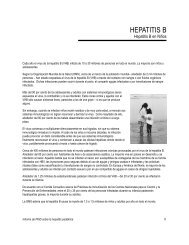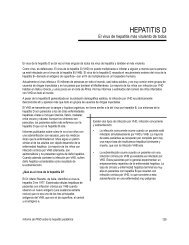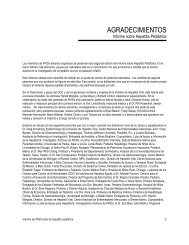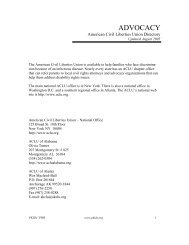Milk Thistle: Effects on Liver Disease and Cirrhosis - Parents of Kids ...
Milk Thistle: Effects on Liver Disease and Cirrhosis - Parents of Kids ...
Milk Thistle: Effects on Liver Disease and Cirrhosis - Parents of Kids ...
Create successful ePaper yourself
Turn your PDF publications into a flip-book with our unique Google optimized e-Paper software.
Summary<br />
Overview<br />
This evidence report details a systematic review summarizing clinical studies <strong>of</strong> milk thistle<br />
in humans. The scientific name for milk thistle is Silybum marianum. It is a member <strong>of</strong> the<br />
aster or daisy family <strong>and</strong> has been used by ancient physicians <strong>and</strong> herbalists to treat a range <strong>of</strong><br />
liver <strong>and</strong> gallbladder diseases <strong>and</strong> to protect the liver against a variety <strong>of</strong> pois<strong>on</strong>s. Two areas are<br />
addressed in the report: (1) effects <strong>of</strong> milk thistle <strong>on</strong> liver disease <strong>of</strong> alcohol, viral, toxin,<br />
cholestatic, <strong>and</strong> primary malignancy etiologies; <strong>and</strong> (2) clinical adverse effects associated with<br />
milk thistle ingesti<strong>on</strong> or c<strong>on</strong>tact. The report was requested by the Nati<strong>on</strong>al Center for<br />
Complementary <strong>and</strong> Alternative Medicine, a comp<strong>on</strong>ent <strong>of</strong> the Nati<strong>on</strong>al Institutes <strong>of</strong> Health, <strong>and</strong><br />
sp<strong>on</strong>sored by the Agency for Healthcare Research <strong>and</strong> Quality (AHRQ).<br />
Reporting the Evidence<br />
Specifically, the report addresses 10 questi<strong>on</strong>s regarding whether milk thistle supplements—<br />
compared with no supplement, placebo, other oral supplements, or drugs—alter the physiological<br />
markers <strong>of</strong> liver functi<strong>on</strong>, reduce mortality or morbidity, or improve the quality <strong>of</strong> life in adults<br />
with alcohol-related, toxin-induced, or drug-induced liver disease, viral hepatitis, cholestasis, or<br />
primary hepatic malignancy. One questi<strong>on</strong> addresses the c<strong>on</strong>stituents <strong>of</strong> comm<strong>on</strong>ly available<br />
milk thistle preparati<strong>on</strong>s, <strong>and</strong> three questi<strong>on</strong>s address the comm<strong>on</strong> <strong>and</strong> uncomm<strong>on</strong> symptomatic<br />
adverse effects <strong>of</strong> milk thistle.<br />
Methodology<br />
Search Strategy<br />
Eleven electr<strong>on</strong>ic databases, including AMED, CISCOM, <strong>and</strong> the Cochrane Library<br />
(including DARE <strong>and</strong> the Cochrane C<strong>on</strong>trolled Trials Registry), EMBASE, MEDLINE, <strong>and</strong><br />
NAPRALERT, were searched through July 1999 using the following terms: carduus marianus,<br />
legal<strong>on</strong>, mariendistel, milk thistle, silybin, silybum marianum, silybum, silychristin, silydianin,<br />
<strong>and</strong> silymarin. An update search limited to PubMed was c<strong>on</strong>ducted in December 1999. English<br />
<strong>and</strong> n<strong>on</strong>-English citati<strong>on</strong>s were identified from these electr<strong>on</strong>ic databases, references in pertinent<br />
articles <strong>and</strong> reviews, drug manufacturers, <strong>and</strong> technical experts.<br />
Selecti<strong>on</strong> Criteria<br />
Preliminary selecti<strong>on</strong> criteria regarding efficacy were reports <strong>on</strong> liver disease <strong>and</strong> clinical <strong>and</strong><br />
physiologic outcomes from r<strong>and</strong>omized c<strong>on</strong>trolled trials (RCTs) in humans comparing milk<br />
thistle with placebo, no milk thistle, or another active agent. Several <strong>of</strong> these r<strong>and</strong>omized trials<br />
had dissimilar numbers <strong>of</strong> subjects in study arms, raising the questi<strong>on</strong> that these were not<br />
actually RCTs but cohort studies. In additi<strong>on</strong>, am<strong>on</strong>g studies using n<strong>on</strong>placebo c<strong>on</strong>trols, the type<br />
<strong>of</strong> c<strong>on</strong>trol varied widely. Therefore, qualitative <strong>and</strong> quantitative syntheses <strong>of</strong> data <strong>on</strong><br />
1






